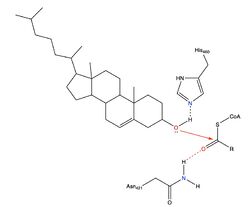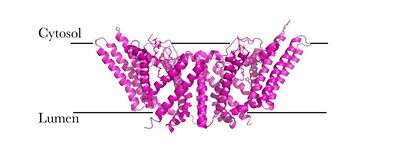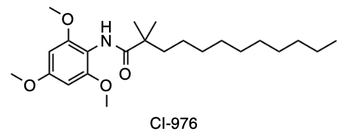User:Madison Unger/Sandbox 1
From Proteopedia
(Difference between revisions)
| Line 17: | Line 17: | ||
However, Qian et al.<ref name="Qian" /> proposed a mechanism involving the important residues His460 and Asn421. In this mechanism, His460 acts as a general base to deprotonate the hydroxyl group on cholesterol, activating it as a [http://en.wikipedia.org/wiki/Nucleophile nucleophile]. Then, Asn421 possibly forms a hydrogen bond with oleoyl-CoA to stabilize the reaction (Fig. 3). | However, Qian et al.<ref name="Qian" /> proposed a mechanism involving the important residues His460 and Asn421. In this mechanism, His460 acts as a general base to deprotonate the hydroxyl group on cholesterol, activating it as a [http://en.wikipedia.org/wiki/Nucleophile nucleophile]. Then, Asn421 possibly forms a hydrogen bond with oleoyl-CoA to stabilize the reaction (Fig. 3). | ||
===Active Site=== | ===Active Site=== | ||
| - | A <scene name='87/ | + | A <scene name='87/877505/Acyl-coa_surface/2'>naturally-occurring substrate</scene> can be found in the active site of ACAT and replaced by cholesterol for synthesis of cholesteryl ester. |
===Tunnels=== | ===Tunnels=== | ||
The nine transmembrane segments create a cytosolic tunnel and a transmembrane tunnel that meet at the site of catalysis (active site). Acyl-coenzyme A enters the active site though the cytosolic tunnel, and cholesterol enters through the transmembrane tunnel. These then meet in the catalytic site to react and form the cholesteryl ester.[[Image:Cytosol lumen pic.jpg|400px|right|thumb|Figure 4: Orientation showing the cytosolic and lumen sides of the dimer]] When exiting the catalytic site, the cholesterol ester is able to release through the <scene name='87/877507/T_tunnel_final/1'>transmembrane tunnel</scene> to the membrane or through the lumen tunnel to the lumen, and the free CoA is able to release through the <scene name='87/877506/C_tunnel_new/4'>cytosolic tunnel</scene> to the cytosol. Certain residues that line the transmembrane tunnel are important in ACAT activity (E259, E263, R262, P304, L306, V423, V424, M265, I261, and H460)<ref name="Qian" />. | The nine transmembrane segments create a cytosolic tunnel and a transmembrane tunnel that meet at the site of catalysis (active site). Acyl-coenzyme A enters the active site though the cytosolic tunnel, and cholesterol enters through the transmembrane tunnel. These then meet in the catalytic site to react and form the cholesteryl ester.[[Image:Cytosol lumen pic.jpg|400px|right|thumb|Figure 4: Orientation showing the cytosolic and lumen sides of the dimer]] When exiting the catalytic site, the cholesterol ester is able to release through the <scene name='87/877507/T_tunnel_final/1'>transmembrane tunnel</scene> to the membrane or through the lumen tunnel to the lumen, and the free CoA is able to release through the <scene name='87/877506/C_tunnel_new/4'>cytosolic tunnel</scene> to the cytosol. Certain residues that line the transmembrane tunnel are important in ACAT activity (E259, E263, R262, P304, L306, V423, V424, M265, I261, and H460)<ref name="Qian" />. | ||
Revision as of 19:57, 12 April 2021
Human Acyl-CoenzymeA
| |||||||||||
References
- ↑ 1.0 1.1 1.2 1.3 Qian H, Zhao X, Yan R, Yao X, Gao S, Sun X, Du X, Yang H, Wong CCL, Yan N. Structural basis for catalysis and substrate specificity of human ACAT1. Nature. 2020 May;581(7808):333-338. doi: 10.1038/s41586-020-2290-0. Epub 2020 May, 13. PMID:32433614 doi:http://dx.doi.org/10.1038/s41586-020-2290-0
- ↑ Cases S, Novak S, Zheng YW, Myers HM, Lear SR, Sande E, Welch CB, Lusis AJ, Spencer TA, Krause BR, Erickson SK, Farese RV Jr. ACAT-2, a second mammalian acyl-CoA:cholesterol acyltransferase. Its cloning, expression, and characterization. J Biol Chem. 1998 Oct 9;273(41):26755-64. doi: 10.1074/jbc.273.41.26755. PMID:9756919 doi:http://dx.doi.org/10.1074/jbc.273.41.26755
- ↑ 3.0 3.1 Guan C, Niu Y, Chen SC, Kang Y, Wu JX, Nishi K, Chang CCY, Chang TY, Luo T, Chen L. Structural insights into the inhibition mechanism of human sterol O-acyltransferase 1 by a competitive inhibitor. Nat Commun. 2020 May 18;11(1):2478. doi: 10.1038/s41467-020-16288-4. PMID:32424158 doi:http://dx.doi.org/10.1038/s41467-020-16288-4
- ↑ Rogers MA, Liu J, Song BL, Li BL, Chang CC, Chang TY. Acyl-CoA:cholesterol acyltransferases (ACATs/SOATs): Enzymes with multiple sterols as substrates and as activators. J Steroid Biochem Mol Biol. 2015 Jul;151:102-7. doi: 10.1016/j.jsbmb.2014.09.008., Epub 2014 Sep 12. PMID:25218443 doi:http://dx.doi.org/10.1016/j.jsbmb.2014.09.008
- ↑ Hartmann T, Kuchenbecker J, Grimm MO. Alzheimer's disease: the lipid connection. J Neurochem. 2007 Nov;103 Suppl 1:159-70. doi: 10.1111/j.1471-4159.2007.04715.x. PMID:17986151 doi:http://dx.doi.org/10.1111/j.1471-4159.2007.04715.x
- ↑ Li J, Gu D, Lee SS, Song B, Bandyopadhyay S, Chen S, Konieczny SF, Ratliff TL, Liu X, Xie J, Cheng JX. Abrogating cholesterol esterification suppresses growth and metastasis of pancreatic cancer. Oncogene. 2016 Dec 15;35(50):6378-6388. doi: 10.1038/onc.2016.168. Epub 2016 May , 2. PMID:27132508 doi:http://dx.doi.org/10.1038/onc.2016.168
- ↑ Rudel LL, Shelness GS. Cholesterol esters and atherosclerosis-a game of ACAT and mouse. Nat Med. 2000 Dec;6(12):1313-4. doi: 10.1038/82110. PMID:11100106 doi:http://dx.doi.org/10.1038/82110
Student Contributors
- Leah Goehring
- Gabby Smith
- Anna Campbell





